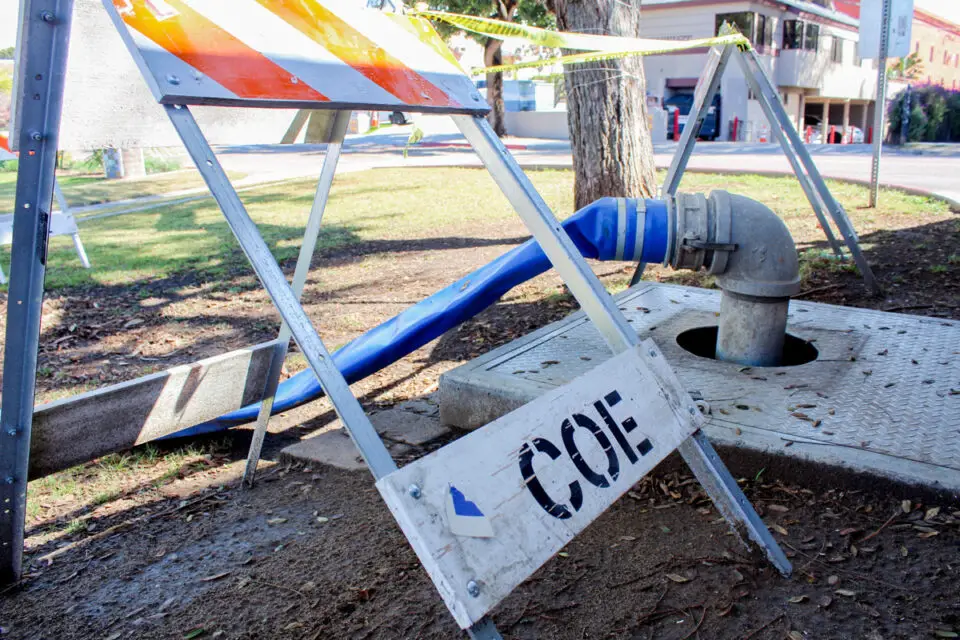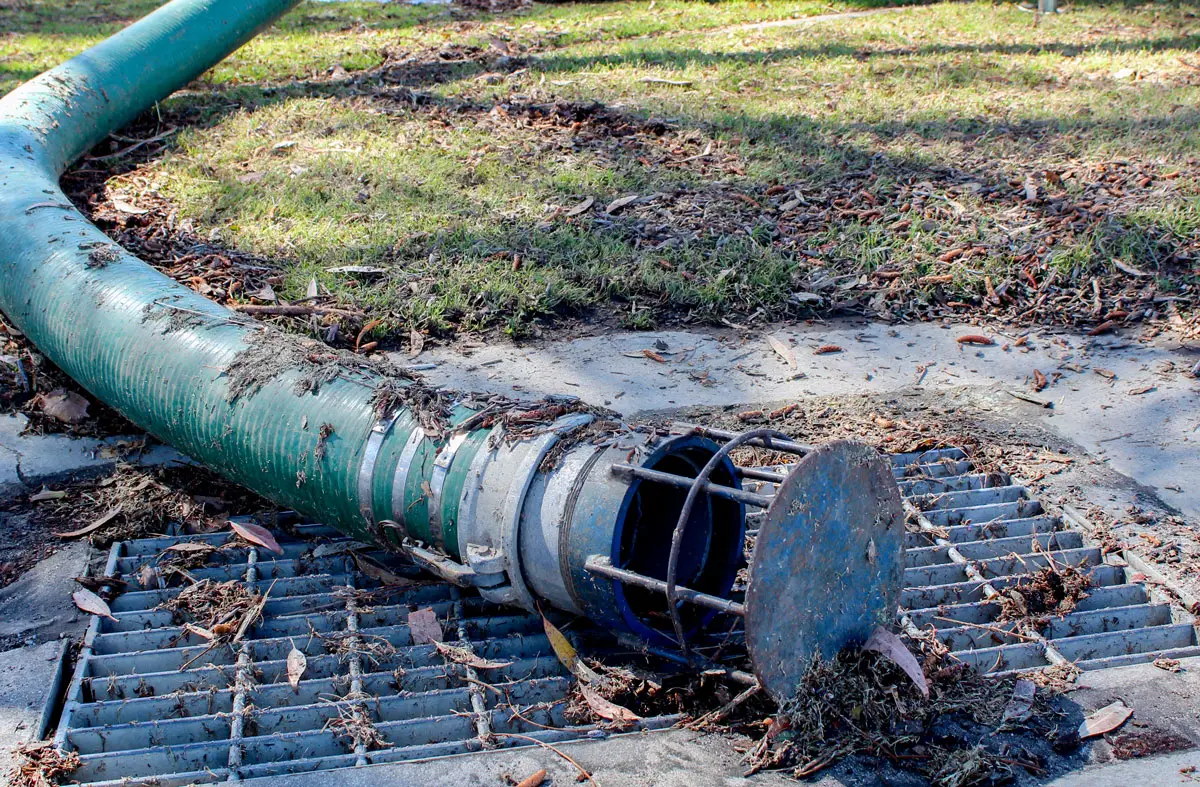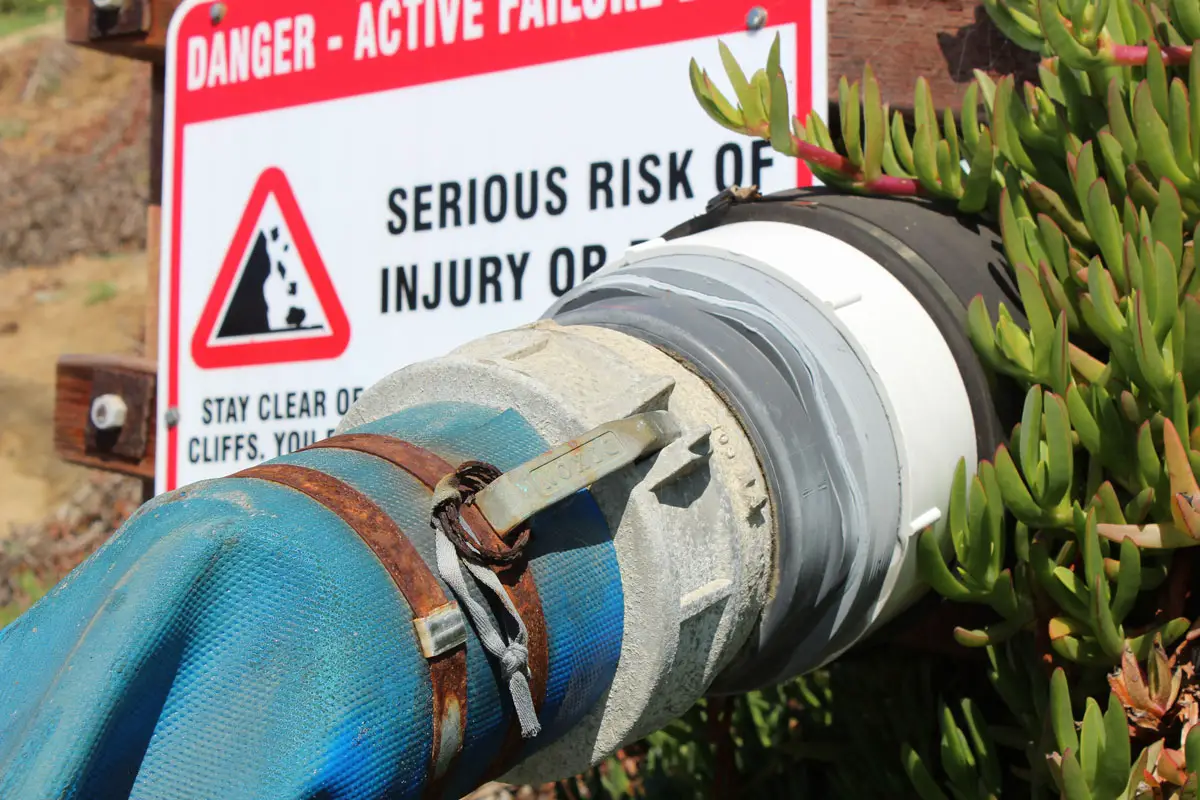ENCINITAS — Jeff, a Leucadia resident who lives on Basil Street, said it was in 2001 when his home first flooded.
“It was two weeks after I moved in, and I had just painted the house and put in new carpeting, so it really wasn’t good timing,” Jeff recalled with a laugh, noting his home would flood again four years later.
But for Jeff and his neighbors who live along North Coast Highway 101 in Leucadia, the issue of flooding in Leucadia has been no laughing matter. For nearly three decades now, Leucadia residents in an area spanning from roughly Basil Street to further north at Ponto Beach have lived with the distinct possibility of flooding during storm seasons.
The flooding not only causes extensive property damage but has had the ripple effect of pushing the city to pump untreated stormwater over the bluff through a pipe and onto nearby Beacon’s Beach, contaminating the coastal area and posing environmental hazards, experts say. Additionally, legal analysts believe the city’s diverting of stormwater from Old Encinitas to Leucadia may be unlawful, opening the city up to litigation.
James Etheridge, who also lives on Basil Street, told The Coast News that numerous homes around his own flooded in 2003, which led to costly repairs for homeowners. Etheridge remembers the severity of that storm to this day.
“The system completely flooded and it filled up Basil Street with a lake for literally days,” Etheridge said. “The water from upstream was shooting through the manholes, lifting the concrete up and flooding the houses.”
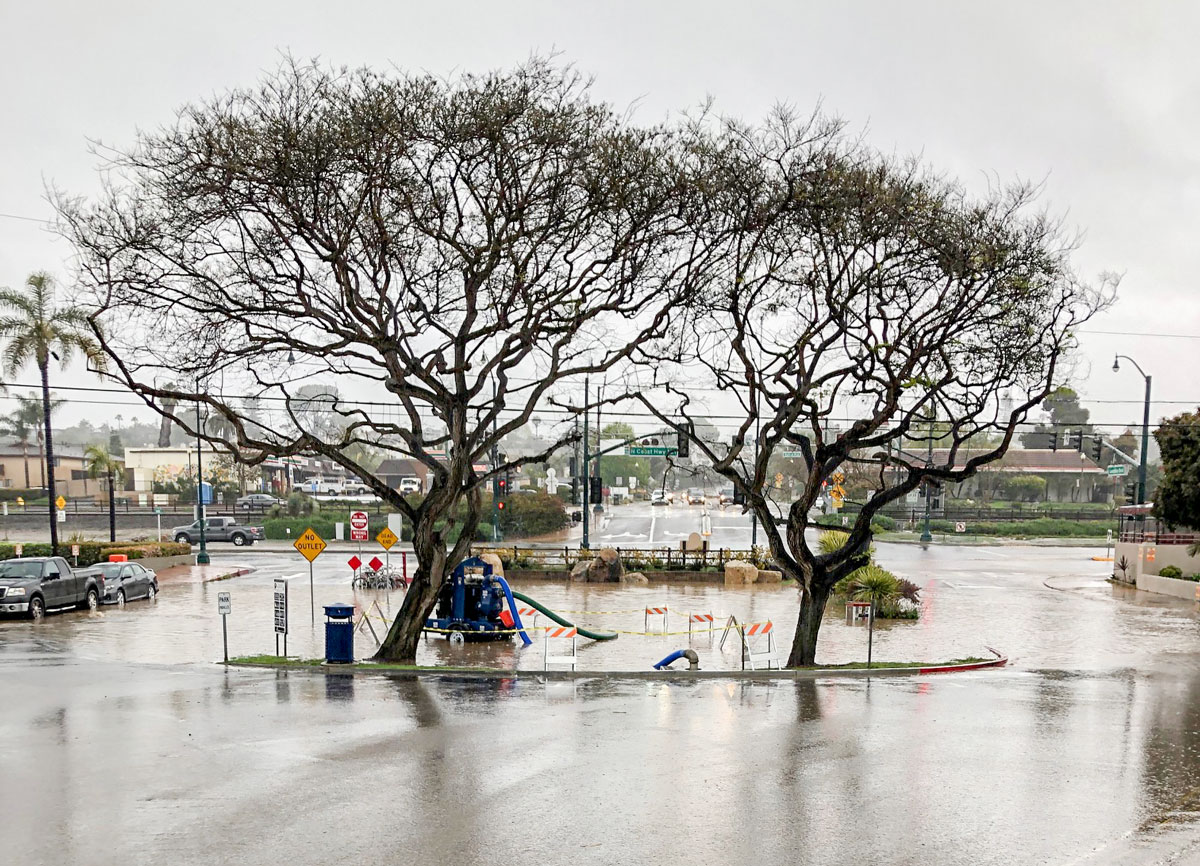
But while the city has largely paid residents for damages caused by severe storms, Etheridge expressed his disappointment with the ways in which the City of Encinitas has handled the flooding through the years.
“Fifteen years ago I was livid about this, but we’ve basically learned to live in a floodplain,” Etheridge said. “You have thousands of gallons of water being diverted into the lowest side of 101 Highway, it’s just bizarre. There are pockets all over Leucadia that are suffering in a similar situation to us. If the [city] hadn’t done anything at all it may have been better than the system that there is now.”
Due to the severity of the flooding threat, the City of Encinitas has developed a longstanding policy of diverting the excess stormwater that causes the flooding from Leucadia Roadside Park to the top of the bluff at Beacon’s Beach, where the water travels through an elevated 8-inch pipe and empties onto the beach and surrounding coastal area, according to a city spokesperson.
This solution is far from ideal, environmental activists and city leaders agree.
“The situation with pumping stormwater over the bluff has never been a very good solution to most people, and especially given the fact that with the system that’s currently in place, there’s still a heck of a lot of flooding that goes on,” said Councilman Tony Kranz, a longtime Leucadia resident who has spoken about the issue of flooding in Leucadia since before he was elected to the council more than a decade ago.
“The effects of stormwater are really bad on our coastal waters,” said Mitch Silverstein, a spokesperson for the Surfrider Foundation. “What you basically get after a rain is a good toxic cocktail of thousands of chemicals too numerous to name ending up in our coastal waters. It’s just horrible for ocean quality.”
If coastal waters are not regularly tested, we will not know when bacterial deposits from stormwater reach hazardous levels, according to environmental and land use attorney Marco Gonzalez, who lives in Encinitas.
Additionally, Gonzalez said the city’s current practice of pumping stormwater over the bluff can both worsen erosion on the coastline and increase the turbidity of the ocean water, which is harmful to animals living on the seafloor and foraging shorebirds.
The County of San Diego says that it does not regularly test or monitor the water quality at Beacon’s Beach.
The City of Encinitas, which is regulated by a regional municipal stormwater permit, told The Coast News it is not required to monitor or treat every stormwater entry point at surface waters for harmful chemicals or bacterial flows.
“The municipal stormwater permit does not establish a requirement to treat or to monitor all stormwater discharges to surface waters, including the Pacific Ocean, from the MS4 (municipal separate storm sewer system),” a city spokesperson wrote. “The City of Encinitas reports on these activities, as required by the municipal stormwater permit, on an annual basis.”
But why does Encinitas have to pump dirty water over the bluffs at all?
The answer resides somewhere in the history and development of the city’s drainage infrastructure, according to longtime Leucadia resident Gary Murphy, who has made efforts to assist the city in developing various designs for storm drainage projects in Leucadia.
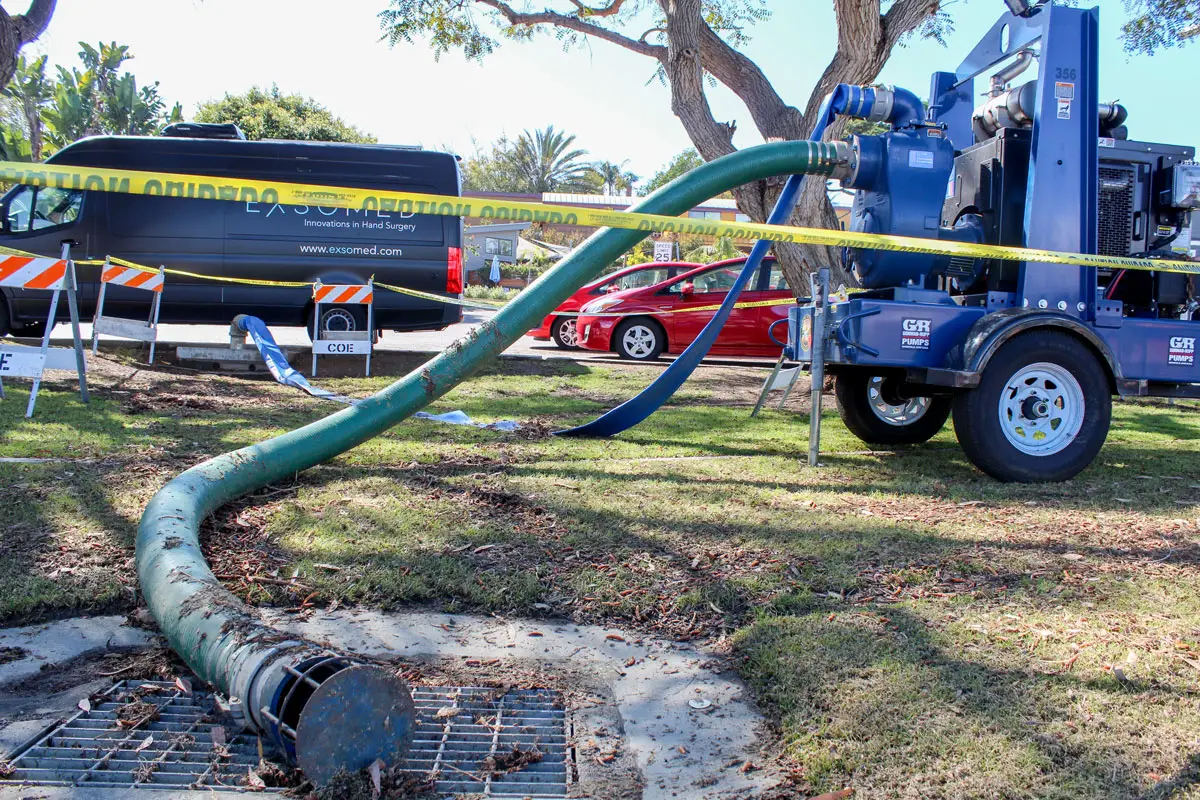
Murphy explained that the flooding in Leucadia has been an issue since the 1990s, and in part stems from deficiencies with the original infrastructure built by the county along Coast Highway 101 prior to the city’s incorporation in 1986.
But in the early 2000s, Murphy said city leadership squandered multiple opportunities to overhaul the Leucadia drainage system and solve its flooding problem.
In 2003, city engineers built a 24-inch nuisance drain, known as the Leucadia Drainage Project, that runs from the south boundary of Leucadia north to the Batiquitos Lagoon at the city’s border with Carlsbad.
According to Murphy, the nuisance drain was originally designed with the capacity to handle Leucadia’s ponding areas on the west side of Coast Highway.
However, city engineers connected the pipe to the water coming further south to the border of the historic Old Encinitas region at Union Street — a decision that doomed the system to fail from the start by overloading the Leucadia drain’s storage capacity, Murphy said.
“There isn’t a single hydrology study to show that the 24-inch pipe was built to be a storm drain capable of handling the water coming from Old Encinitas,” Murphy said. “It was built to be a nuisance drain, only designed to handle nuisance water and small amounts of ponding.”
In a 2017 email correspondence with Assistant City Manager Mark Delin provided to The Coast News, Kipp Hefner, a retired associate civil engineer with the city of Encinitas, wrote: “[The] 24-inch storm drain is grossly undersized and can only handle a 2-year storm.”
Instead of simply handling Leucadia’s water that settles on the west side of the railroad tracks, the 24-inch drain now takes in a vast outflow of water coming from the east side of the tracks in an area along Vulcan spanning from Orpheus Avenue in the south all the way north to RCP Block and Brick.
In 2012, the San Diego County Grand Jury released a report in agreement with Murphy and Heffner that Leucadia’s 24-inch pipe was far too small to meet the city’s drainage needs.
“The project was forced into under-design from the beginning,” the report reads.
The Grand Jury noted while Leucadia watershed engineers’ original analysis called for a 9-foot pipe, this idea was scrapped because the California Coastal Commission demanded that the pipe’s outflow at the Batiquitos Lagoon be no more than 24 inches in diameter.
But the flooding in Leucadia isn’t solely the result of a 24-inch pipe being too small, Murphy says. Instead, he expressed that a pattern of subsequent errors and poor policy choices since 2003 have worsened the problem.
The Sluice-Gate Valve
When the Leucadia storm drain was constructed, the city installed a sluice-gate valve located south of Leucadia Boulevard off Vulcan Avenue, directly in front of RCP. The goal of this valve was to regulate the water flow during storms coming from east of the tracks to the west side.
By keeping this valve closed during storms, the city’s Public Works department could allow the downstream areas along the west side of Coast Highway 101 to fully dry out before opening the valve to drain water ponding further upstream on the east side.
But for unknown reasons, Murphy said the city has inexplicably left the valve open during storms since 2007, overwhelming the drain’s capacity.

When the water flows unrestrained across the tracks during storms, Murphy explained the sheer volume of outflow closes Leucadia’s tide-flex valves, which are essential to allowing the coastal inlets to drain excess stormwater.
Once the tide-flex valves close, the inlets no longer drain properly and the surrounding neighborhoods in Leucadia become inundated with floodwater, necessitating the pumping of the stormwater over the bluff at Beacons Beach.
“By diverting the water coming from Orpheus and Vulcan through the sluice-gate valve, you overload the tide flex valves, making none of the inlets work and putting the residents in jeopardy of flooding and then you get the pumping of water over the bluffs,” Murphy said.
When pressed for comment on the sluice-gate valve issue, the city said the valve is kept slightly open in order to avoid potential flooding that would purportedly occur on the east side of the tracks at the Vulcan and Union intersection when the valve was closed.
“Full closure of this gate valve would flood the Vulcan/Union intersection and adjacent mobile home community,” a city spokesperson said.
However, the city engineer who designed the Leucadia Storm Drain Project, Dennis Bowling of Rick Engineering, disagreed with the city’s assessment. Bowling said the valve was specifically designed to be kept closed in order to keep Leucadia’s inlets from being overwhelmed during a major storm event.
“It is our recommendation to the City of Encinitas that the gate remain closed at all times to serve as a restriction to the rate at which runoff can cross from the east side of the NCTD right-of-way to the west side, to mimic the historic drainage patterns in this area,” Bowling said in a 2009 email correspondence shared with The Coast News.
“The gate would not be opened until the rain event has ended and the downstream ponding areas along the Alleys and along Highway 101 have drained. At that time the storm drain system would be available to drain the ponded water upstream of 101 without causing additional flooding downstream. The gate allows maintenance crews to control the rate at which water leaves the ponded area specifically to avoid causing inundation downstream.”
Diverting Water South
Perhaps the biggest mistake related to Leucadia’s drainage infrastructure, according to Murphy, is the decision to direct water from Old Encinitas north towards Batiquitos Lagoon.
Murphy and Kranz both expressed bewilderment as to why the city does not divert the water that ponds south of Union and Vulcan to the nearby Cottonwood Creek watershed at Moonlight Beach, which they agree would spare the Leucadia storm system from being overtaxed.
“You have all of this stormwater being diverted from Orpheus and Vulcan north to Ponto Beach 1.75 miles away, instead of being diverted south to Cottonwood Creek which is just a third of a mile to the south,” Murphy said. “What is that?”
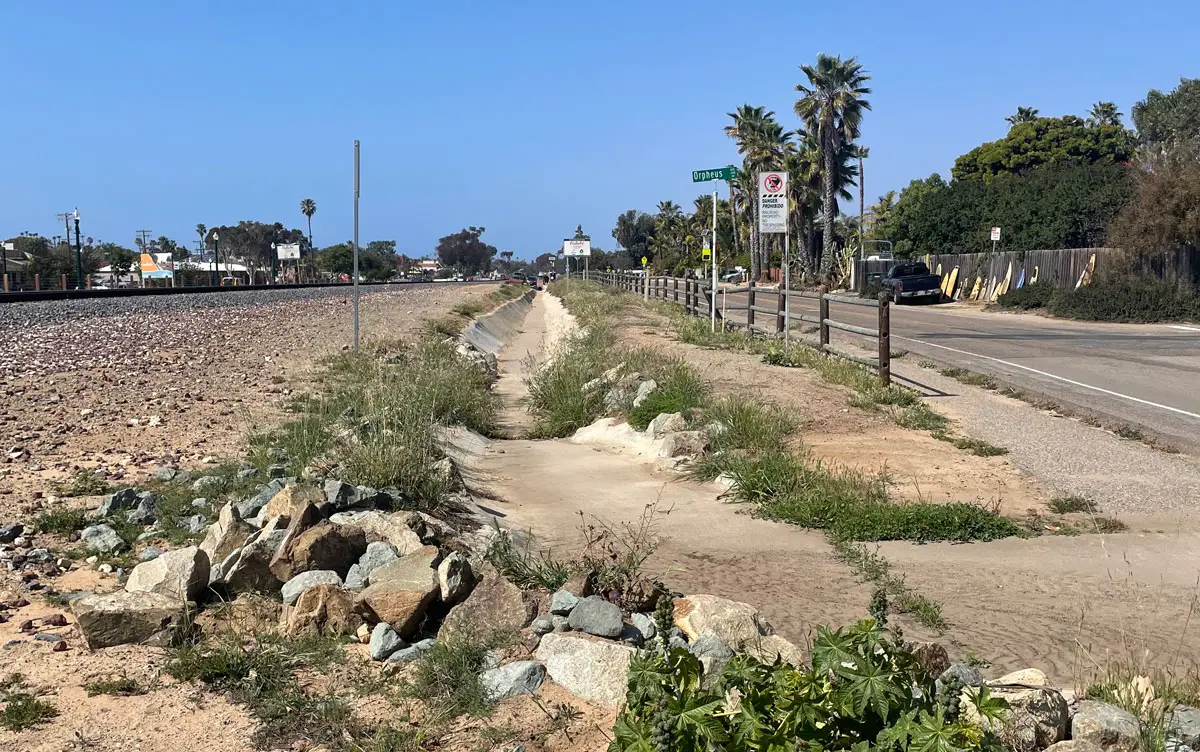
During an Encinitas City Council meeting in 2012, Kranz, then speaking as a concerned Leucadia resident, requested more transparency from city leadership and shared his thoughts on diverting stormwater north.
“I’m certain that most of the water Leucadia is dealing with should be going south instead of north,” Kranz said during the meeting. “Personally, I’ve never understood why the stormwater coming down Orpheus on the east side of the tracks was being run in stormwater systems to the west side of the tracks and especially directed north because it’s so much further to get to the [Batiquitos] Lagoon than it would be to get to Cottonwood Creek.”
In an email response on the subject, the city claimed diverting the water south would not be feasible, as “the existing storm drains west of Cottonwood Creek are not large enough to handle the significant volume of drainage on Vulcan.”
But according to email correspondences obtained by The Coast News, the city’s own civil engineers disagreed with the assessment that Cottonwood Creek would be unable to accommodate the drainage coming from Vulcan.
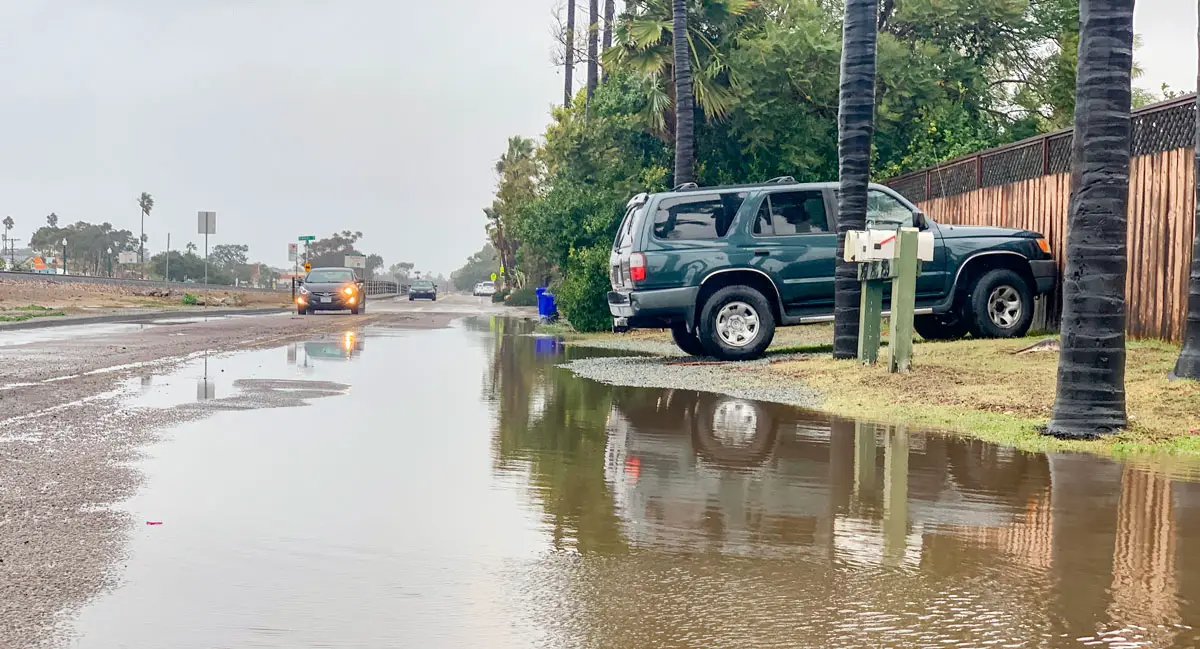
In a 2017 email, Hefner said that engineers had developed plans to build a new storm drain that would run down Vulcan Avenue and connect to an existing 78-inch pipe on Encinitas Boulevard, with the stormwater discharge then being diverted into the Cottonwood Creek watershed. To date, the city has not adopted any of these plans.
Kranz said that he hasn’t gotten a clear answer from the city as to what hydrology studies have been conducted to support the city’s claim that water coming from Old Encinitas can’t be diverted south.
“I think we should definitely be doing that [diverting water south],” Kranz said. “My goal as a councilman is to continue advocating for reasonable solutions, and the notion that the water from Orpheus ends up in Batiquitos Lagoon is kind of crazy.”
Gonzalez agreed, expressing that the city seems to have missed multiple opportunities with past infrastructure projects to find a way to divert the excess water south to Cottonwood Creek.
“What’s frustrated Tony, myself and others, is that it seems as though there were opportunities to address this by taking the stormwater from the east side of the tracks and moving it down towards Moonlight Beach, and that hasn’t been done,” Gonzalez said. “There’s no legal obligation to do it, but would it be smart to do that? Yes, it would.”
Legal Element
Multiple legal experts say that in addition to the flooding in Leucadia being costly and destructive, it may actually open the city up to lawsuits from affected residents.
Established judicial case law in California prohibits a municipality from diverting stormwater from one natural watershed to another if it causes a flooding problem where one previously didn’t exist, according to Dr. Dave Owen, an environmental water and land use professor at the University of California Hastings Law School.
While there is no specific state statute governing this field of law, Owen says that property owners have rights afforded by both the state and federal constitutions that protect their properties from flooding damages.
This notion of liability is based on a longstanding case precedent theorem known as “inverse condemnation theory,” and dates back to Locklin vs City of Lafayette, a 1992 state Supreme Court decision.
Under Locklin, inverse condemnation theory established that a city can be held strictly liable for damages caused to downstream properties when water is unnaturally diverted, even if the diversion itself is accidental, according to Phillip L. Pillsbury, who litigated the Locklin case on behalf of the plaintiffs.

“When alterations or improvements on upstream property discharge an increased volume of surface water into a natural watercourse, and the increased volume and/or velocity of the stream waters or the method of discharge into the watercourse causes downstream property damage, a public entity, as a property owner, may be liable for that damage,” Locklin reads.
For Encinitas, Locklin means the city’s longstanding policy of diverting Old Encinitas’s water across the railroad tracks into the Leucadia drainage system could be unlawful and open the city up to litigation, Pillsbury said.
“With [Encinitas] this sounds like a reasonable case from a plaintiff’s perspective,” Pillsbury said. “You have a municipality, the city, diverting water from one watershed to another, I think that the court may well find the city strictly liable in inverse condemnation.” (Strict liability means liability without regard to fault, whether that fault was intentional or negligent.)
The City of Encinitas denies having any legal exposure through inverse condemnation theory. According to a city spokesperson, Encinitas and Leucadia lie within the same natural watershed, meaning there is no diversion occurring between separate watersheds.
However, according to water and land use attorney Bradford Kuhn, the city still runs the risk of unlawful diversion within the same watershed if it can be proven that flooding damages are being caused to downstream private properties.
“If water is being diverted through a public improvement or onto a private property causing flooding damages, they still have that exposure to liability and inverse condemnation theory would still apply,” Kuhn said.
Pillsbury also disagreed with the city’s assessment.
“What the city is saying is not true,” Pillsbury said. “Regardless of whether it’s the same watershed, it’s not true, because if you unreasonably impacted downstream landowners and caused damages — and that appears to be what happened here — the city is still liable.”
Moving Forward
The 2012 Grand Jury report concluded, “existing stormwater infrastructure is not sufficient to serve the needs of Leucadia.”
At the time, the report asked the Encinitas City Council to develop an immediate plan of action to solve the flooding problem and proposed levying a special tax to fund capital improvements for an infrastructure project.
But 10 years later, the city acknowledges that Leucadia’s drainage system has not undergone any such improvements.
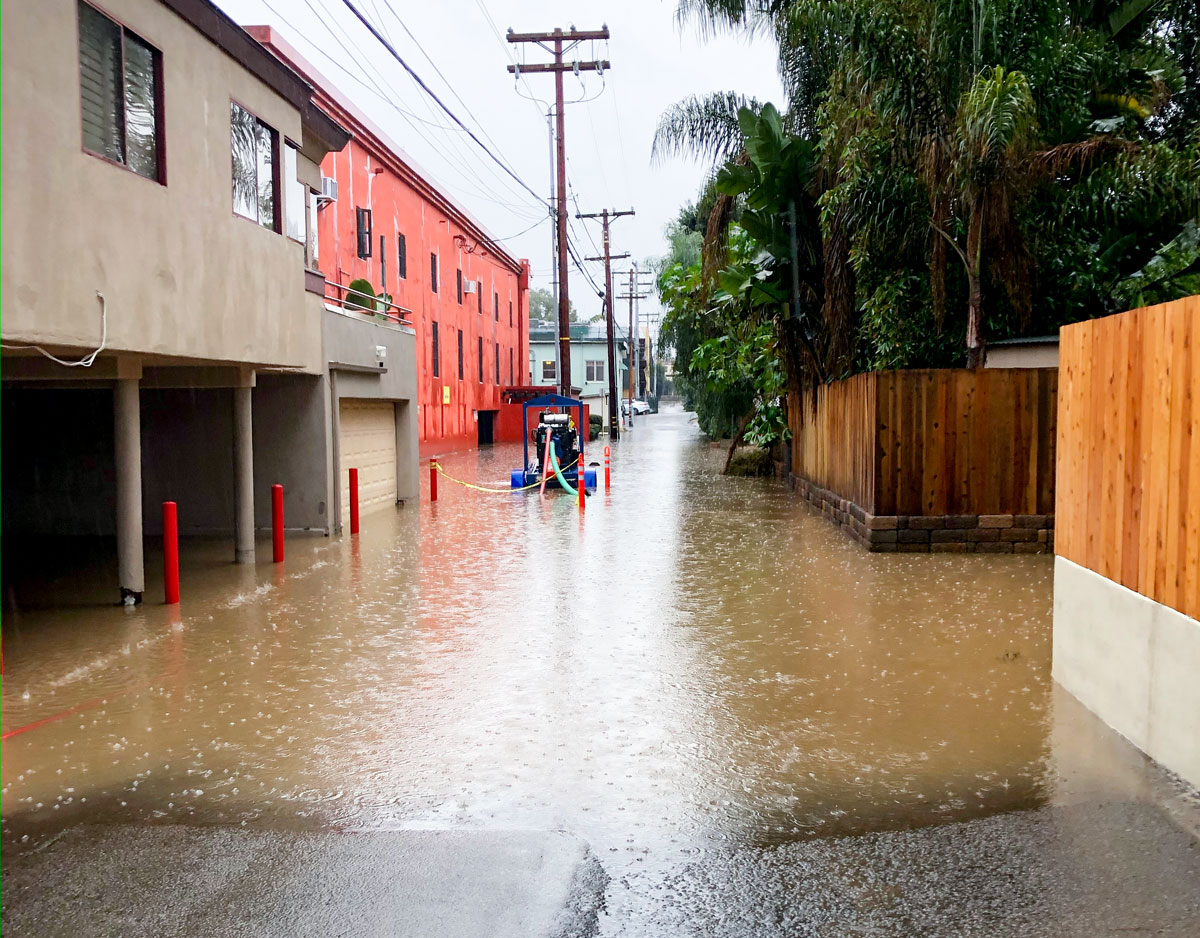
A city spokesperson said that Encinitas has repeatedly sought funding at the state and federal levels for drainage projects, but grant applications for those funds have been denied.
However, Kranz said the city needs to “redouble” its efforts on seeking grant funding. Any such capital infrastructure projects will be in the millions of dollars, and such costs will be a high hurdle for an already cash-strapped city.
“Historically, Encinitas has always had a list of capital projects longer than the resources that are available,” Kranz said. “We recognize that addressing the flooding is very important, but it’s a question of how to pay for it, it’s going to be many millions of dollars and that’s tough.”
Another barrier to fixing the flooding in Leucadia is bureaucratic challenges, the city says.
To build new pipes, fix existing drainage or make other similar improvements requires clearance from a number of government agencies. Kranz also noted receiving clearance for such projects from the Coastal Commission, in particular, has been a significant challenge in years prior.
For instance, the Coastal Commission has repeatedly shot down the city’s efforts to install a larger pipe to accommodate a greater volume of outflow than the current 24-inch nuisance drain in Leucadia.
“It’s been frustrating for me because there have been things on the drawing board that have just disappeared and I’ve been told that they keep getting set aside for one bureaucratic reason or another,” Kranz said.
But Kranz says that a potential solution to Leucadia’s drainage woes may be on the horizon.
The city is currently considering an improvement project along the 101 that would see the installation of an 8,300 ft. pipe that would run underneath North Coast Highway 101 from approximately Basil Street in the south as far north as La Costa Avenue.
The diameter of the pipe would vary between 36 inches and 60 inches, installing a wider pipe along sections of the watershed to accommodate greater drainage capacity than in other areas.
The North Coast Highway 101 Streetscape Improvement Project would take care of Leucadia’s excess stormwater, effectively making the current 24-inch drainage system only responsible for the water coming from the east side of the railroad tracks, Kranz said.
The nuisance drain would no longer be overloaded beyond capacity during storms and would allow the inlets on the west side to function properly, ending the flooding in Leucadia and the need to pump water over the bluff at Beacon’s Beach.
However, the Improvement Project is far from being realized, Kranz acknowledges. The project would be an addendum to the current Leucadia Streetscape project, which is aimed at reducing traffic congestion along the 101.
But that construction project is currently on pause, as the city must wait for certain regulatory approvals from the Coastal Commission, as well as for the approval of a $20 million loan sought from the state needed to fund Streetscape. Once these hurdles are cleared, the city would put out a bid to find a suitable construction firm willing to undertake the Improvement Project at a cost the city can afford.
“The [project] would make a significant difference,” Kranz said. “The major challenge is coming up with the money, with the budgeting process for Streetscape. We have constrained budgets, and we have to figure out how to direct these resources.”
As a result of these challenges, the councilman declined to give an estimate of when construction on the Improvement Project might start.
While Murphy agrees with the councilman that the Improvement Project would likely benefit Leucadia, he still strongly believes the city should move the stormwater from the Union and Vulcan intersection south to Cottonwood Creek, which he says has the capacity to handle the excess stormwater.
100-year storm
But even if the new pipe is built along the 101, Kranz acknowledges the project is not designed to prepare Leucadia’s infrastructure for the event of a 100-year-storm, though he emphasized that it would still be a significant structural improvement over the overloaded 24-inch nuisance drain.
Leucadia residents say that they’re worried about the impact that a major storm event could have on their properties.
“Leucadia isn’t even built to handle a 25-year storm right now, much less a 50 year or 100 year…forget about it,” said Murphy. Murphy pointed out that Leucadia has gotten lucky in recent years because of poor rains, but warned that continued inaction could mean disaster in the event of a major storm event.
Mike James, who lives on Cadmus Street off Coast Highway 101, said he’s already dealt with flooding issues even with the low levels of rainfall.
“If it rains a whole lot, we’re done,” James said. “With a 100-year storm I’ll be underwater and the amount of damage that’ll happen, I don’t even know.”
Jeff said that while he’s grateful that the city is working towards a solution with the Improvement Project, he’s frustrated that the project doesn’t go beyond accommodating a 25-year-storm. And as the Improvement Project continues to linger in limbo, climate change and rising sea levels have Jeff concerned about what a major storm event could do to the coastal city’s already overwhelmed drainage system.
“I was really hoping that they would put in something with a 100-year flood capacity, while this new system is only going to have a 25-year storm capacity-so yea I’m worried about that 100-year storm,” Jeff said.
Murphy and Etheridge both said Leucadia residents are frustrated and concerned by the city’s overall lack of transparency on the issue.
“It seems like what makes sense for the citizens just doesn’t come into play. (City officials) have an agenda of their own, whether it’s money or whatever,” Etheridge said. “Instead of saying let’s figure out a solution to this, they ignore it, they try to push you out…it’s really a beautiful case of bureaucracy.”
Murphy agreed, expressing disappointment in what he called a systematic lack of communication from city staff to residents affected by the flooding.
“Tony Kranz said himself in 2012 that transparency is the number one thing on this, and it’s my opinion that the city has not had the staff, the leadership, or the management that really knows what’s been happening with drainage or how to answer these questions,” Murphy said.
“I’ve never wanted to go at odds with the city, all I ever did was try to get them to listen to ideas that would make residents’ lives easier in the low-lying areas of Leucadia and stop the pumping of dirty water over the bluff at Beacons Beach.
“Nobody is out to attack the city of Encinitas for anything that they’ve done wrong or accidentally overlooked, but we have to be transparent with residents so that the quality of life in Encinitas is at its fullest. If we have a city that is not transparent to the citizens of that city, then we don’t have a city at all.”
EDITOR’S NOTE: The phrase “pumping untreated stormwater over the bluff” is used by many of those interviewed for this article. To clarify, the diverted stormwater does not run freely down the bluff face but rather it travels through an elevated pipe and empties onto Beacon’s Beach.

